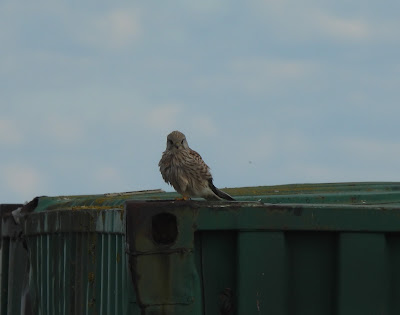Dungeness - mild, overcast, light airs - We spent the morning wandering around the point searching for grounded migrants, of which there were few and far between, considering the time of year and weather conditions. Chiffchaffs continue to be the most numerous passerine in the bushes with around 20 noted across the trapping area, plus a couple each of Cetti`s Warbler and Blackcap. Yellow-browed Warblers have been reported in good numbers all down the east coast of Britain and the northern isles these past few weeks, but it takes them a bit longer to `get around the corner` so`s to speak. The first one was last Sunday on the bird reserve at the pines and another one/two were in the trapping area this morning; mine was a heard only at the southern end of the pilot path where I also had my first Goldcrest of autumn. Other migrants included a trickle of Swallows, Meadow Pipits and Skylarks overhead, a few Robins, a Siskin, a Reed Bunting, a Great Spotted Woodpecker and a Jay by long pits, while at least 12 Kestrels were noted. Checked the beach out from the Tavern viewpoint on the way home where c300 Curlews and c500 Oystercatchers were the main news, plus four Knots, two Shelducks and ten Sandwich Terns.

Yellow-browed Warbler (DBO 2018)
For many of us birders the sycamore tree is synonymous with autumn migrants, particularly leaf warblers and crests. From Scilly to the north Norfolk coast and many places in between, I must`ve spent countless hours scanning the bronzed canopies of these hardy trees searching for that elusive sprite, so it was sad to see that the mature sycamore in the old lighthouse garden at Dungeness has been needlessly grubbed up, to be replaced with a view of a tin shed! In my time I can recall seeing Short-toed Treecreeper, Dusky, Pallas`s and Yellow-browed Warblers in that tree, and as a result can kind of empathise with folk who got very upset when the famous Sycamore Gap tree on Hadrian`s Wall was chopped down last year.
Old lighthouse garden, Dungeness
Elsewhere since my last post we`ve been out and about daily but there hasn`t been very much to report. Water levels on the bird reserve and Lade are rising fast where Wigeons and Golden Plovers are starting to arrive in numbers. A few Snipe have been reported, while a late Garganey and Hobby have been seen on ARC along with the usual egrets and ibis. Chiffchaffs and Kestrels remain the most obvious migrants, particularly the former which seem to be everywhere. Offshore, seawatching has been mostly disappointing, despite favourable winds, with a few shearwaters noted amongst the usual terns and skuas and returning divers and Brents.





















































